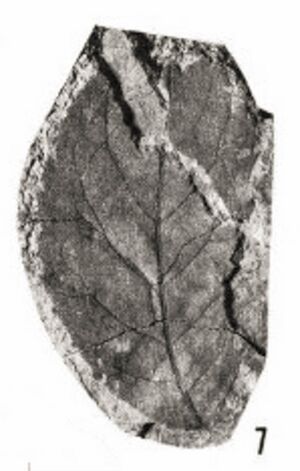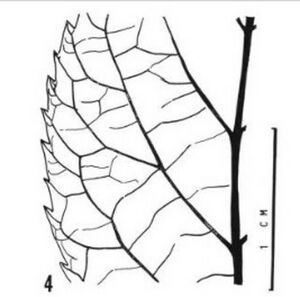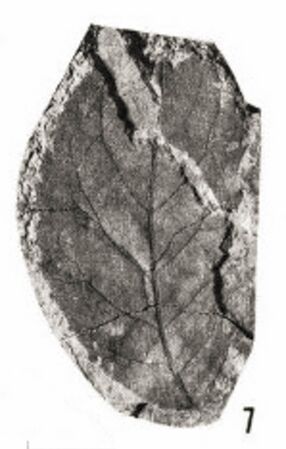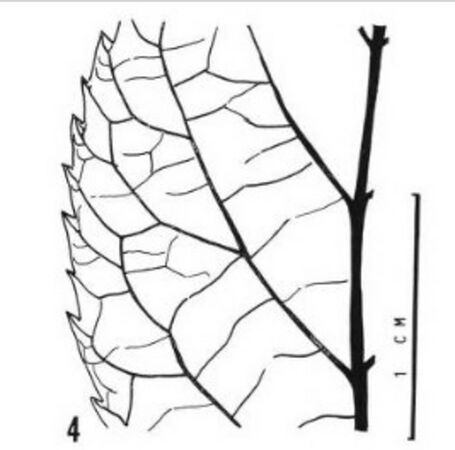Rosa okamotoi Tanai et K.Uemura
Fossile-Rose, 1991 - beschrieben von den Paläobotanikern/ described by the palaeobotanists/ décrit par les paléobotanistes Toshimasa Tanai und Kazuhiko Uemura Japan/ Japon
Eltern/ parentage/ parents: Botanische Rose/ Wild Rose/ Rosier botanique
Synonyme/ synonyms/ synonymes:
Allgemeines • Preface • Remarques
Benannt haben die beiden japanischen Paläobotaniker Toshimasa Tanai und Kazuhiko Uemura diesen fossilen Fund zu Ehren von Professor Kazuo Okamato, der viel Zeit zur Erforschung der Geologie und Paläontologie des Yuya-wan-Gebietes aufgewendet hat. Das fossile Blatt stammt aus dem Spätoligozän[1], ist also ca. 23 Mio. Jahre alt.
The two Japanese palaeobotanists Toshimasa Tanai and Kazuhiko Uemura named this fossil find in honour of Professor Kazuo Okamato, who spent a lot of time researching the geology and palaeontology of the Yuya-wan region. The fossilised leaflets date back to the Late Oligocene[1], which means they are around 23 million years old.
Les deux paléobotanistes japonais Toshimasa Tanai et Kazuhiko Uemura ont nommé cette découverte fossile en l'honneur du professeur Kazuo Okamato, qui a consacré beaucoup de temps à l'étude de la géologie et de la paléontologie de la région de Yuya-wan. La feuille fossile date de la fin de l'oligocène[1], c'est-à-dire d'environ 23 millions d'années.
Originale Beschreibung • Original description • Description originale
Übersetzung:
Rosa okamotoi TANAI et UEMURA, Sp. nov.
(Pl. 3, fig. 7; Fig. 4)
Typus: Holotyp NSM-PP 10394; Noda, Heki-cho, Yamaguchi Pref.; Kiwado Formation (Spätoligozän).
Diagnose: Fiederblatt etwas ungleichseitig, elliptisch, 5,5 cm lang (geschätzt) und 2,8 cm breit; Basis stumpf; Apex fehlt; Rand gesägt; Zähne spitz mit drüsiger Spitze (Zahntyp C1 oder C2); Blattstiel fehlt. Blattnerven gefiedert; Mittelader dick; 8 oder 9 (geschätzt) paarweise gegenüberliegende, spitzwinklig abzweigende, sanft nach oben gebogene, kammförmige Nebenvenen; 3 oder 4 von den Nebenvenen ausgehende, spitzwinklig abzweigende Nebenvenen, die große Schlingen bilden; Zwischenrippen-Tertiärvenen dünn, unregelmäßig verlaufend; Rand-Tertiärvenen, die von den großen Schlingen abzweigen und zentral in die Zähne münden; Venen höherer Ordnung undeutlich.
Diskussion: Die Randschleifen der sekundären und subsekundären Adern und der gezackte Rand mit spitzen und drüsig gespitzten Zähnen sind Merkmale der Rosaceae. Die gebogene Mittelader und die asymmetrische Form deuten darauf hin, dass es sich bei diesem Exemplar um ein Seitenblättchen der Rosa handelt. Im Tertiär Ostasiens ist keine fossile Rosenart mit diesem Fossil vergleichbar; alle zuvor beschriebenen fossilen Fiederblättchen von Rosa sind noch kleiner als dieses Fossil.
Diese Art wurde in Anerkennung von Professor Kazuo OKAMOTO benannt, der viel Zeit für die Geologie und Paläontologie des Yuya-wan-Gebietes aufgewendet hat.
Sammlung: Holotypus NSM-PP 10394.
Original:
Rosa okamotoi TANAI et UEMURA, Sp. nov.
(Pl. 3, fig. 7; Fig. 4)
Typus: Holotype NSM-PP 10394; Noda, Heki-cho, Yamaguchi Pref.; Kiwado Formation (Late Oligocene).
Diagnosis: Leaflet somewhat inequilateral, elliptic, 5.5 cm long (estimated) and 2.8 cm wide; base obtuse; apex missing; margin serrate; teeth acute with glandular pointed tip (tooth type C1 or C2); petiolule missing. Venation pinnate; midvein thick; secondary veins 8 or 9 (estimated) in opposite pairs, diverging at acute angles, gently curving up, camptodromous; 3 or 4 subsecondary veins from the secondary diverging at acute angles to form large loops; intercostal tertiary veins thin, irregularly percurrent; marginal tertiaries diverging from large loops, entering teeth centrally; higher order veins indistinct.
Discussion: The marginal loops of secondary and subsecondary veins, and serrate margin with acute and glandular-tipped teeth are features of Rosaceae. The arcuate midvein and asymmetric shape indicate that this specimen represents a lateral leaflet of Rosa. No fossil rose species is comparable to this fossil in the Tertiary of East Asia; all fossil leaflets of Rosa described earlier are further smaller than this fossil.
This species is named in recognition of Professor Kazuo OKAMOTO who has devoted much time for geology and paleontology of the Yuya-wan area.
Collection: Holotype NSM-PP 10394.
Traduction:
Rosa okamotoi TANAI et UEMURA, Sp. nov.
(Pl. 3, fig. 7; Fig. 4)
Typus : Holotype NSM-PP 10394 ; Noda, Heki-cho, Yamaguchi Pref. ; Formation Kiwado (Oligocène tardif).
Diagnostic : Foliole quelque peu inéquilatérale, elliptique, 5,5 cm de long (estimation) et 2,8 cm de large ; base obtuse ; apex manquant ; marge dentée ; dents aiguës avec pointe glandulaire (type de dent C1 ou C2) ; pétiolule manquant. Vennation pennée ; nervure centrale épaisse ; veines secondaires 8 ou 9 (estimation) en paires opposées, divergeant à des angles aigus, s'incurvant doucement vers le haut, camptodromes ; 3 ou 4 veines sous-secondaires de la secondaire divergeant à des angles aigus pour former de grandes boucles ; veines tertiaires intercostales minces, irrégulièrement percurrentes ; tertiaires marginales divergeant des grandes boucles, entrant dans les dents au centre ; veines d'ordre supérieur indistinctes.
Discussion : Les boucles marginales des veines secondaires et subsecondaires, et la marge dentelée avec des dents aiguës et glanduleuses sont des caractéristiques des Rosaceae. La nervure centrale arquée et la forme asymétrique indiquent que ce spécimen représente une foliole latérale de Rosa. Aucune espèce de rose fossile n'est comparable à ce fossile dans le Tertiaire de l'Asie de l'Est ; toutes les folioles fossiles de Rosa décrites précédemment sont encore plus petites que ce fossile.
Cette espèce est nommée en reconnaissance du professeur Kazuo OKAMOTO qui a consacré beaucoup de temps à la géologie et à la paléontologie de la région de Yuya-wan.
Collection : Holotype NSM-PP 10394.
Fundort • Find location • Lieu de découverte
Gefunden wurde Rosa okamotoi Tanai et K.Uemura in der Oligozänen Noda-Flora aus dem Yuya-wan-Gebiet[2] am westlichen Ende der Insel Honshu[3], Japan.
Rosa okamotoi Tanai et K.Uemura was found in the Oligocene Noda flora from the Yuya-wan Area[2] of the western western end of the island of Honshu[3], Japan.
Rosa okamotoi Tanai et K.Uemura a été trouvée dans la flore oligocène de Noda de la région de Yuya-wan[2] à l'extrémité ouest de l'île de Honshu[3], Japon.
- Rosa okamotoi
Zum Vergrößern anklicken • click to enlarge • cliquez pour agrandir
↑ Nach oben • Top • Vers le haut ↑
Einzelnachweis • Footnotes • Notes
Weblinks • External links • Liens externes
Literatur • Literature • Littérature
- Toshimasa Tanai, Kazuhiko Uemura, The Oligocene Noda Flora from the Yuya-wan Area of the Western End of Honshu, Japan. Part 1, 1991 Seite 74 - Text u. Seite 70, Plate 3, Fig. 7 u. Seite 73, Fig. 4



